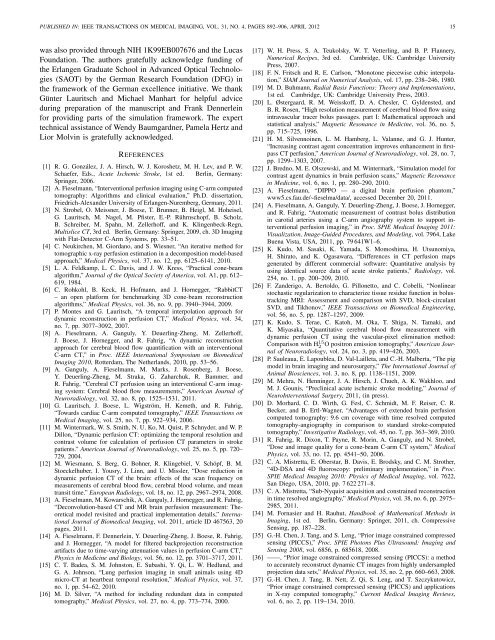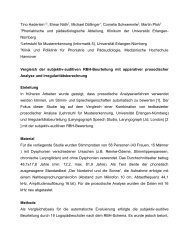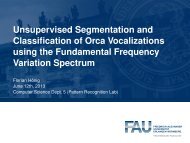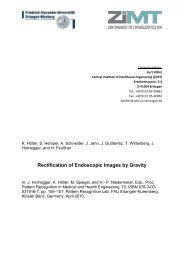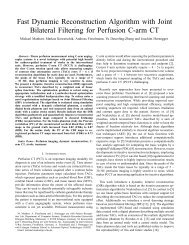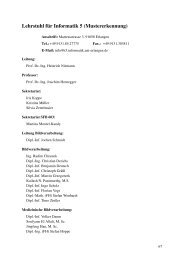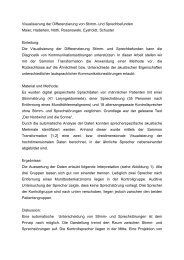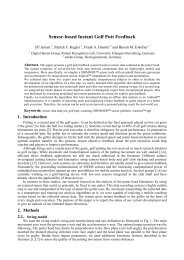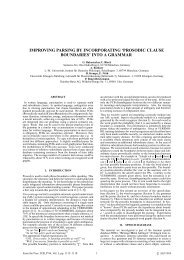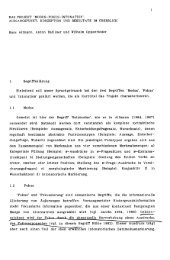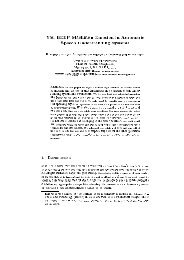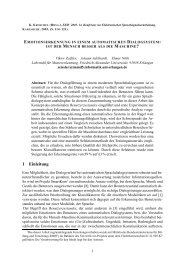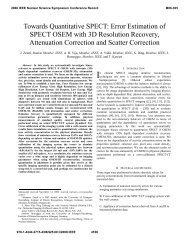Interventional 4-D C-Arm CT Perfusion Imaging Using Interleaved ...
Interventional 4-D C-Arm CT Perfusion Imaging Using Interleaved ...
Interventional 4-D C-Arm CT Perfusion Imaging Using Interleaved ...
Create successful ePaper yourself
Turn your PDF publications into a flip-book with our unique Google optimized e-Paper software.
PUBLISHED IN: IEEE TRANSA<strong>CT</strong>IONS ON MEDICAL IMAGING, VOL. 31, NO. 4, PAGES 892–906, APRIL 2012 15was also provided through NIH 1K99EB007676 and the LucasFoundation. The authors gratefully acknowledge funding ofthe Erlangen Graduate School in Advanced Optical Technologies(SAOT) by the German Research Foundation (DFG) inthe framework of the German excellence initiative. We thankGünter Lauritsch and Michael Manhart for helpful adviceduring preparation of the manuscript and Frank Dennerleinfor providing parts of the simulation framework. The experttechnical assistance of Wendy Baumgardner, Pamela Hertz andLior Molvin is gratefully acknowledged.REFERENCES[1] R. G. González, J. A. Hirsch, W. J. Koroshetz, M. H. Lev, and P. W.Schaefer, Eds., Acute Ischemic Stroke, 1st ed. Berlin, Germany:Springer, 2006.[2] A. Fieselmann, “<strong>Interventional</strong> perfusion imaging using C-arm computedtomography: Algorithms and clinical evaluation,” Ph.D. dissertation,Friedrich-Alexander University of Erlangen-Nuremberg, Germany, 2011.[3] N. Strobel, O. Meissner, J. Boese, T. Brunner, B. Heigl, M. Hoheisel,G. Lauritsch, M. Nagel, M. Pfister, E.-P. Rührnschopf, B. Scholz,B. Schreiber, M. Spahn, M. Zellerhoff, and K. Klingenbeck-Regn,Multislice <strong>CT</strong>, 3rd ed. Berlin, Germany: Springer, 2009, ch. 3D <strong>Imaging</strong>with Flat-Detector C-<strong>Arm</strong> Systems, pp. 33–51.[4] C. Neukirchen, M. Giordano, and S. Wiesner, “An iterative method fortomographic x-ray perfusion estimation in a decomposition model-basedapproach,” Medical Physics, vol. 37, no. 12, pp. 6125–6141, 2010.[5] L. A. Feldkamp, L. C. Davis, and J. W. Kress, “Practical cone-beamalgorithm,” Journal of the Optical Society of America, vol. A1, pp. 612–619, 1984.[6] C. Rohkohl, B. Keck, H. Hofmann, and J. Hornegger, “Rabbit<strong>CT</strong>– an open platform for benchmarking 3D cone-beam reconstructionalgorithms,” Medical Physics, vol. 36, no. 9, pp. 3940–3944, 2009.[7] P. Montes and G. Lauritsch, “A temporal interpolation approach fordynamic reconstruction in perfusion <strong>CT</strong>,” Medical Physics, vol. 34,no. 7, pp. 3077–3092, 2007.[8] A. Fieselmann, A. Ganguly, Y. Deuerling-Zheng, M. Zellerhoff,J. Boese, J. Hornegger, and R. Fahrig, “A dynamic reconstructionapproach for cerebral blood flow quantification with an interventionalC-arm <strong>CT</strong>,” in Proc. IEEE International Symposium on Biomedical<strong>Imaging</strong> 2010, Rotterdam, The Netherlands, 2010, pp. 53–56.[9] A. Ganguly, A. Fieselmann, M. Marks, J. Rosenberg, J. Boese,Y. Deuerling-Zheng, M. Straka, G. Zaharchuk, R. Bammer, andR. Fahrig, “Cerebral <strong>CT</strong> perfusion using an interventional C-arm imagingsystem: Cerebral blood flow measurements,” American Journal ofNeuroradiology, vol. 32, no. 8, pp. 1525–1531, 2011.[10] G. Lauritsch, J. Boese, L. Wigström, H. Kemeth, and R. Fahrig,“Towards cardiac C-arm computed tomography,” IEEE Transactions onMedical <strong>Imaging</strong>, vol. 25, no. 7, pp. 922–934, 2006.[11] M. Wintermark, W. S. Smith, N. U. Ko, M. Quist, P. Schnyder, and W. P.Dillon, “Dynamic perfusion <strong>CT</strong>: optimizing the temporal resolution andcontrast volume for calculation of perfusion <strong>CT</strong> parameters in strokepatients.” American Journal of Neuroradiology, vol. 25, no. 5, pp. 720–729, 2004.[12] M. Wiesmann, S. Berg, G. Bohner, R. Klingebiel, V. Schöpf, B. M.Stoeckelhuber, I. Yousry, J. Linn, and U. Missler, “Dose reduction indynamic perfusion <strong>CT</strong> of the brain: effects of the scan frequency onmeasurements of cerebral blood flow, cerebral blood volume, and meantransit time.” European Radiology, vol. 18, no. 12, pp. 2967–2974, 2008.[13] A. Fieselmann, M. Kowarschik, A. Ganguly, J. Hornegger, and R. Fahrig,“Deconvolution-based <strong>CT</strong> and MR brain perfusion measurement: Theoreticalmodel revisited and practical implementation details,” InternationalJournal of Biomedical <strong>Imaging</strong>, vol. 2011, article ID 467563, 20pages, 2011.[14] A. Fieselmann, F. Dennerlein, Y. Deuerling-Zheng, J. Boese, R. Fahrig,and J. Hornegger, “A model for filtered backprojection reconstructionartifacts due to time-varying attenuation values in perfusion C-arm <strong>CT</strong>,”Physics in Medicine and Biology, vol. 56, no. 12, pp. 3701–3717, 2011.[15] C. T. Badea, S. M. Johnston, E. Subashi, Y. Qi, L. W. Hedlund, andG. A. Johnson, “Lung perfusion imaging in small animals using 4Dmicro-<strong>CT</strong> at heartbeat temporal resolution,” Medical Physics, vol. 37,no. 1, pp. 54–62, 2010.[16] M. D. Silver, “A method for including redundant data in computedtomography,” Medical Physics, vol. 27, no. 4, pp. 773–774, 2000.[17] W. H. Press, S. A. Teukolsky, W. T. Vetterling, and B. P. Flannery,Numerical Recipes, 3rd ed. Cambridge, UK: Cambridge UniversityPress, 2007.[18] F. N. Fritsch and R. E. Carlson, “Monotone piecewise cubic interpolation,”SIAM Journal on Numerical Analysis, vol. 17, pp. 238–246, 1980.[19] M. D. Buhmann, Radial Basis Functions: Theory and Implementations,1st ed. Cambridge, UK: Cambridge University Press, 2003.[20] L. Østergaard, R. M. Weisskoff, D. A. Chesler, C. Gyldensted, andB. R. Rosen, “High resolution measurement of cerebral blood flow usingintravascular tracer bolus passages. part I: Mathematical approach andstatistical analysis,” Magnetic Resonance in Medicine, vol. 36, no. 5,pp. 715–725, 1996.[21] H. M. Silvennoinen, L. M. Hamberg, L. Valanne, and G. J. Hunter,“Increasing contrast agent concentration improves enhancement in firstpass<strong>CT</strong> perfusion,” American Journal of Neuroradiology, vol. 28, no. 7,pp. 1299–1303, 2007.[22] J. Bredno, M. E. Olszewski, and M. Wintermark, “Simulation model forcontrast agent dynamics in brain perfusion scans,” Magnetic Resonancein Medicine, vol. 6, no. 1, pp. 280–290, 2010.[23] A. Fieselmann, “DIPPO — a digital brain perfusion phantom,”www5.cs.fau.de/~fieselma/data/, accessed December 20, 2011.[24] A. Fieselmann, A. Ganguly, Y. Deuerling-Zheng, J. Boese, J. Hornegger,and R. Fahrig, “Automatic measurement of contrast bolus distributionin carotid arteries using a C-arm angiography system to support interventionalperfusion imaging,” in Proc. SPIE Medical <strong>Imaging</strong> 2011:Visualization, Image-Guided Procedures, and Modeling, vol. 7964, LakeBuena Vista, USA, 2011, pp. 79 641W1–6.[25] K. Kudo, M. Sasaki, K. Yamada, S. Momoshima, H. Utsunomiya,H. Shirato, and K. Ogasawara, “Differences in <strong>CT</strong> perfusion mapsgenerated by different commercial software: Quantitative analysis byusing identical source data of acute stroke patients,” Radiology, vol.254, no. 1, pp. 200–209, 2010.[26] F. Zanderigo, A. Bertoldo, G. Pillonetto, and C. Cobelli, “Nonlinearstochastic regularization to characterize tissue residue function in bolustrackingMRI: Assessment and comparison with SVD, block-circulantSVD, and Tikhonov,” IEEE Transactions on Biomedical Engineering,vol. 56, no. 5, pp. 1287–1297, 2009.[27] K. Kudo, S. Terae, C. Katoh, M. Oka, T. Shiga, N. Tamaki, andK. Miyasaka, “Quantitative cerebral blood flow measurement withdynamic perfusion <strong>CT</strong> using the vascular-pixel elimination method:Comparison with H 152 O positron emission tomography,” American Journalof Neuroradiology, vol. 24, no. 3, pp. 419–426, 2003.[28] P. Sauleaua, E. Lapoublea, D. Val-Lailleta, and C.-H. Malberta, “The pigmodel in brain imaging and neurosurgery,” The International Journal ofAnimal Biosciences, vol. 3, no. 8, pp. 1138–1151, 2009.[29] M. Mehra, N. Henninger, J. A. Hirsch, J. Chueh, A. K. Wakhloo, andM. J. Gounis, “Preclinical acute ischemic stroke modeling,” Journal ofNeuro<strong>Interventional</strong> Surgery, 2011, (in press).[30] D. Morhard, C. D. Wirth, G. Fesl, C. Schmidt, M. F. Reiser, C. R.Becker, and B. Ertl-Wagner, “Advantages of extended brain perfusioncomputed tomography: 9.6 cm coverage with time resolved computedtomography-angiography in comparison to standard stroke-computedtomography,” Investigative Radiology, vol. 45, no. 7, pp. 363–369, 2010.[31] R. Fahrig, R. Dixon, T. Payne, R. Morin, A. Ganguly, and N. Strobel,“Dose and image quality for a cone-beam C-arm <strong>CT</strong> system,” MedicalPhysics, vol. 33, no. 12, pp. 4541–50, 2006.[32] C. A. Mistretta, E. Oberstar, B. Davis, E. Brodsky, and C. M. Strother,“4D-DSA and 4D fluoroscopy: preliminary implementation,” in Proc.SPIE Medical <strong>Imaging</strong> 2010: Physics of Medical <strong>Imaging</strong>, vol. 7622,San Diego, USA, 2010, pp. 7 622 271–8.[33] C. A. Mistretta, “Sub-Nyquist acquisition and constrained reconstructionin time resolved angiography,” Medical Physics, vol. 38, no. 6, pp. 2975–2985, 2011.[34] M. Fornasier and H. Rauhut, Handbook of Mathematical Methods in<strong>Imaging</strong>, 1st ed. Berlin, Germany: Springer, 2011, ch. CompressiveSensing, pp. 187–228.[35] G.-H. Chen, J. Tang, and S. Leng, “Prior image constrained compressedsensing (PICCS),” Proc. SPIE Photons Plus Ultrasound: <strong>Imaging</strong> andSensing 2008, vol. 6856, p. 685618, 2008.[36] ——, “Prior image constrained compressed sensing (PICCS): a methodto accurately reconstruct dynamic <strong>CT</strong> images from highly undersampledprojection data sets,” Medical Physics, vol. 35, no. 2, pp. 660–663, 2008.[37] G.-H. Chen, J. Tang, B. Nett, Z. Qi, S. Leng, and T. Szczykutowicz,“Prior image constrained compressed sensing (PICCS) and applicationsin X-ray computed tomography,” Current Medical <strong>Imaging</strong> Reviews,vol. 6, no. 2, pp. 119–134, 2010.


